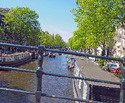| 5/9/2016 AMSTERDAM, The Netherlands What do you think of when someone says Amsterdam? Tulips might be a response for Holland in general but, for Amsterdam, think canals or bicycles or dykes or endless attached house, or houseboats or a red light district. On second thought, instead of saying "or", If it weren′t for dykes, there would be no Amsterdam or at least it would be a great deal smaller. For centuries, the Dutch have been terraforming the land around them to create solid land for buildings and farms. They identify an area, surround it by dykes and pump the water out of the center. The pumps are the famous windmills of Holland and there were thousands in their heyday (today the pumps are electric). The water table everywhere in Amsterdam and its surrounding region is checked non-stop and pumped dry whenever necessary, which is almost always. Canals (and rivers and lakes are the second most famous sight of Amsterdam. Three main canals make up the core of the city and numerous smaller canals link them together. There is also a river, several lakes, and the sea. Canals not only make the engineering feat of creating the very land the city is built on possible but canals are the arteries that were used to move the goods that made Amsterdam a premier trading center. Along these canals, on both sides (and elsewhere), are what is laughingly called roads (or streets). You can imagine that a city that creates every single square inch of the land it has by constantly battling the water table would be parsimonious with the resulting reclaimed land. Streets tend to be one way and if someone stops on the street, say to make a delivery, it is a no-way street (we complain about parallel parking but in this city backing up for long distances is a necessity also). These scarce streets are shared by tens of thousands of inhabitants and tourists, all of whom seem to be in the same place at the same time.       And the streets are also shared, or should I say, taken over by bicycles. People in America who want to transform our city into a place that is bicycle-centric ought to come to Amsterdam and see what they wish for. Admittedly, this city could not function if everyone didn′t move around by bicycle but experiencing the chaos of everyone going everywhere at the same time by bicycle is at times frightening, especially for the bicycle-unaccustomed tourist trying to walk. Parking for cars is almost nonexistent and when there is parking, the charges are astronomical. But that is getting equally problematic for bicycles. The city is thinking of making bicycle users also pay to park downtown because      it is just that congested. Near the harbor, a new structure has recently been created to park 3,000 of them, but that doesn′t seem to have solved the problem. Then there′s the problem of finding your own bike in a sea of them. It′s a real treasure hunt. Maybe people should think about chip implant technology, like they may already be doing for their pets. Talking of treasure, the bikes are old and not in very good shape because those worth stealing, are. As already described, land has historically been so scarce that the houses and businesses end up being glued to each other on both sides of the canals (think Venice) and right on top of the narrow roads. Historically, structures were taxed on the linear frontage of the structure, not total square feet. To combat the taxman, homes became narrow, but also deep and several stories high. We saw some that could not have been more than 10 feet wide. But narrow deep houses make for difficulty in getting large items up and down stairs. With another burst of creativity, those houses incorporated hoists into their design that were used to move items from street level to upper stories.      If you can′t live next to a canal, you can live in the canal on a houseboat. Houseboats come in all sizes and shapes and are in evidence even in the rivers outside the city center.      Like all urban areas, people of like nationality or occupation or trade often congregate in their own sectors. So there is a Jewish community, a Chinese community, a diamond district and so forth. Our guide said that 140 plus nationalities are represented in Amsterdam. There is also a red light district. Like retail shops everywhere, the windows are adorned with, shall we say, come hither advertising. This district was formally declared legal about 15 years ago and is regulated. Before that this district′s "work" wasn′t technically legal but has been openly tolerated forever.      Our final stop of the day was a Dutch community outside of Amsterdam called Broek in Waterland-Noord. The village was so picturesque
Make up your own comments. This one′s too easy.
|